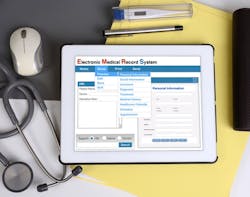MedStar, AMA Launch Campaign to Improve Poor EHR Usability
MedStar Health’s National Center for Human Factors in Healthcare and the American Medical Association (AMA) have launched a new campaign that aims to push for changes to address the known risks to patient safety and clinician burnout that stem from poor EHR (electronic health record) usability.
In their latest joint effort, Washington, D.C.-based MedStar and the AMA are making available, for the first time, videos from the clinician's point of view that demonstrate the risks and challenges caused by poor EHR usability. The videos have just been made available on a new website, EHRSeeWhatWeMean.org, and they present “compelling evidence for the need to act,” according to officials.
MedStar executives said they built the video website based on research they conducted recently on the usability of Cerner and Epic products, which comprise more than 50 percent of the market. The research findings, published in the Journal of the American Medical Informatics Association, involved 12 to 15 emergency physicians from four health systems (two using Cerner and two using Epic) who were given common tasks mimicking real patient cases—placing orders for medical imaging, lab tests and medications. The findings showed huge variability in performance across the sites.
"The results of this study reinforce the assessment that ensuring the usability and safety of EHRs is a joint responsibility between physicians, technology vendors and technology purchasers that requires collaboration with these stakeholders at each stage of design, development and implementation," said AMA CMIO Michael Hodgkins, M.D. "The healthcare system must have confidence in the EHR systems used to manage patient care."
As such, the website specifically calls out what multiple stakeholders—policymakers, healthcare providers, EHR vendors and patients—can do. The theme of the website and campaign is “everybody has responsibilities” to stress the need for increased collaboration through a variety of “calls to action.”
For example, the campaign calls on patients to be aware and engaged in their care by signing up for patient portals and checking their EHRs regularly. For policymakers, officials have pointed out that Congress must prioritize safety in the EHR Reporting Program that is already mandated by the 21st Century Cures Act. Policymakers should also do things such as encourage basic design standards for EHRs and promote safety testing of implemented EHR products, according to the campaign. Providers, meanwhile, ought to participate in usability and safety testing for these products, and be well aware of common EHR usability and safety hazards post-implementation. And finally, the EHR vendors themselves should be engaging in an array of tasks, such as: employ a user-centered design process; conduct rigorous testing; guide providers on implementations; and support a national database for usability and safety reporting.
The campaign comes on the 10th anniversary of the Health Information Technology for Economic and Clinical Health (HITECH) Act, and as part of this new push for greater EHR usability and safety, MedStar is gathering signatures on a letter to the elected leaders of Senate and House committees encouraging them to prioritize EHR usability and safety in their oversight of new policies being put in place by the Department of Health and Human Services (HHS). Central to this effort is the EHR Reporting Program, as part of the Cures Act, officials attest.
"EHR safety must be a priority for all stakeholders. Nearly every high-risk industry promotes the sharing of safety information to foster improvement, and health information technology should be no different," Raj M. Ratwani, Ph.D., a leading EHR safety researcher and director of the MedStar Health National Center for Human Factors in Healthcare, said in a statement.
The letter to Congress urging them to ensure safety is prioritized in the EHR Reporting Program is being made available for healthcare stakeholders to sign by the end of the month.


